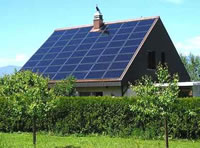
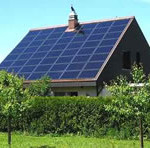 Solar power is the fastest growing energy technology in the world, and works exceptionally well even in the UK’s northern climate. Many thousands of people in the UK are now using solar photovoltaics (PV) to generate electricity from their roof, or using solar thermal (ST) to create hot water for their washing or space heating needs.
Solar power is the fastest growing energy technology in the world, and works exceptionally well even in the UK’s northern climate. Many thousands of people in the UK are now using solar photovoltaics (PV) to generate electricity from their roof, or using solar thermal (ST) to create hot water for their washing or space heating needs.
In the last few years solar has boomed globally, with countries like Germany installing vast quantities of both PV and ST on roofs, commercial buildings and even in fields. The German government is expecting to get 50% of its daytime electricity needs from solar PV by 2020. People in Sweden and Denmark are using fields full of solar thermal panels to heat their homes, as it is cheaper than any other form of heating fuel. Solar has no moving parts, a long lifetime expectancy and requires minimal maintenance. It truly is the fuel of the future.
A large number of homes in the UK have recently been installing PV systems, and the number is increasing exponentially since the introduction of the Feed in Tariff (FiT) – the financial incentive scheme introduced by Government on 1st April 2010. The aim of the FiT is to increase the uptake of on-site electricity generating technologies including PV.
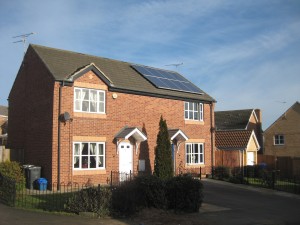 Solar Electricity (Photovoltaics or ‘PV’)
Solar Electricity (Photovoltaics or ‘PV’)
Energy from the sun can be used to generate electricity through a PV system. Solar PV systems convert the sun’s rays directly into electricity through the use of solar cells. The technology can be used for domestic as well as larger industrial or commercial applications and has various applications to suit specific needs.
When electricity rather than heat is required, PV is a robust, flexible, scaleable technology which can provide energy for both houses and other buildings. The typical sized household PV system for example will provide at least 2,000 units of electricity per annum and save at least 1.14 tonnes of carbon dioxide annually. PV has a proven working life of 45 years plus and modules typically come with a 25 year manufacturers warranty. Electricity generation in the UK today is still largely sourced from fossil fuels, which causes the release of harmful gasses into the atmosphere – including CO2. The use of solar electricity generation through Photovoltaic (PV) systems will help to reduce the emission of these gases thereby helping government to meet their binding 2020 emission reduction targets.
The typical PV system is made up of the following parts:
PV panel:
This is made of cells that help to convert energy from the sun directly into electricity. The cells are made of silicon and are connected to form modules which may be either in series, parallel or both. The modules should be durable and be able to withstand temperature variations and humidity.
There are three main types of solar cells as below:
â—¦Mono-crystalline:
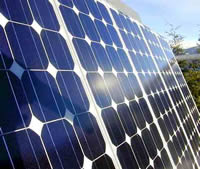
These are cells made from pure mono-crystalline silicon with a single thin crystalline structure. They are very efficient; however the cost of production is high as it is energy and labour intensive. This would be useful for small installations or areas with very limited mounting space.
â—¦Poly-crystalline:
![]()
These are made from small grains of mono-crystalline silicon. They are cheaper and easier to manufacture but are also found to be less efficient than their mono-crystalline counterpart.
â—¦Amorphous Silicon:
These are cells made from thin films of silicon in a form known as amorphous silicon. Here the silicon structures are in less order than the crystal lattice structure of the mono crystalline and the poly crystalline. Its production method though complex, is not as energy intensive as crystalline cells; however its efficiency is low. This technology is most often used in smaller applications such as calculators, or garden lights. It is also often found in multi-layer technology which increases cost, performance and efficiency typically to crystalline levels.
Inverters:
PV systems generate electricity in direct current (DC), however most appliances found in the home operate on alternating current (AC). Transformation of the DC to AC is done by the inverter, and they come in various sizes depending on the user’s energy needs. Battery powered devices also work on DC whilst the mains is supplied through 230 volts AC. The inverter also has several important safety features which protect electricians and householders from electrical dangers.
Storage batteries:
These are used to store excess energy produced by the system which can be used at night when the system can’t produce energy. Alternatively, excess energy stored here can be exported to the grid. If the grid is available, it is always preferable to use grid-connected PV circuits.
Feed in Tariff (FiT)
The use of PV systems is not only cost effective by saving you energy bills, but it is also a form of investment especially with the introduction of the feed in tariff. The FiT scheme is available for people who have an electrical micro generation technology installed in their homes and this could be in form of on-site wind turbines, anaerobic digestion, hydro electricity and combined heat and power (mCHP) and of course PV.
How does the FiT work?
To qualify for the FiT, the PV system must be installed anytime from 15th July 2009.
Benefits of the FiT
There are three ways in which the owner of the technology can benefit from the scheme. These are:
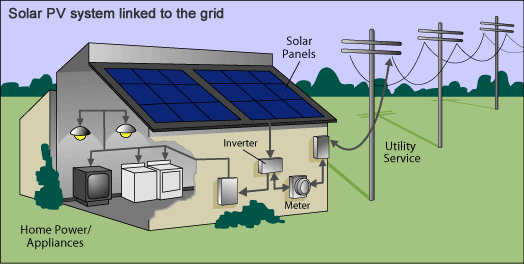
We employ reliable professionals who are trained to deal with all aspects of electrical faults. AA Electrical Services is a reputable installation, repair and maintenance service company covering the South East area. Our team of electricians provides you with maintenance of your electrical installation and appliances as well as a fast and reliable breakdown service. Recognising current British standards, our electrical engineers are NICEIC registered, Part P accredited and qualified to 17th edition standard, as certified by the Institute of Electrical Engineers (IEE). This enables us to offer the highest levels of professional service to you.